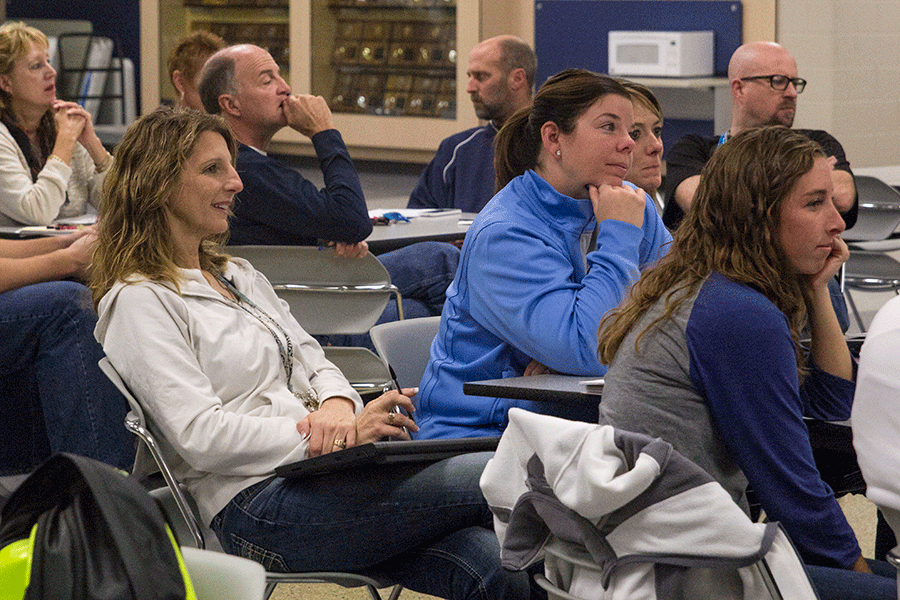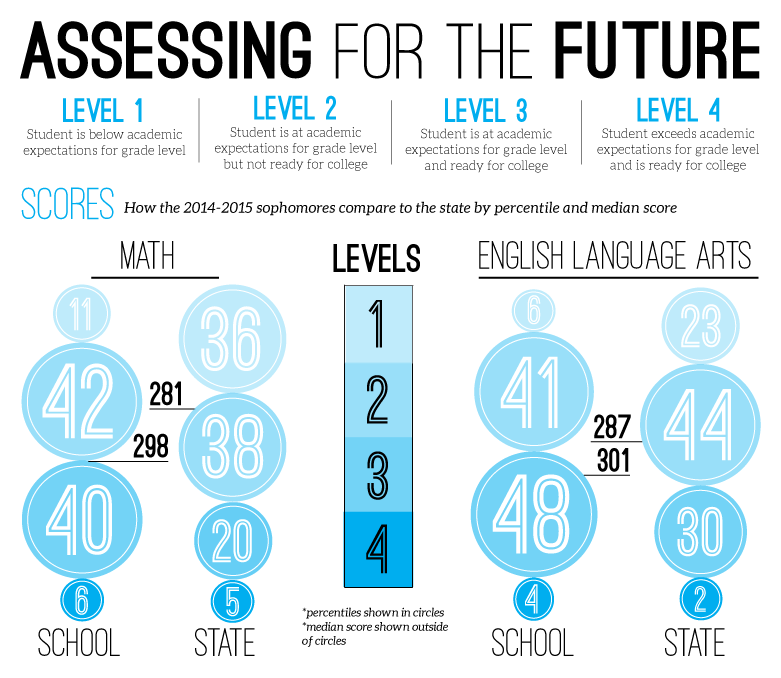District reveals state assessment scores
School’s state assessment scores change due to a shift to a new assessment format
By Nick Precht
Along with the rest of the teaching departments, math teachers Laurie Deuschle and Kristen Chavez review the new state assessments and scoring standards on Friday, Oct. 30.
November 19, 2015
The district revealed its preliminary state assessment scores to the Board of Education on Monday, Nov. 2. On the Mathematics assessment, 88 percent of Mill Valley students were performing at grade level and in English Language Arts, 93 percent were performing at grade level. 46 percent of the school’s students were on track for college and career readiness according to the Mathematics assessment, compared to 52 percent on the ELA assessment.
Although associate principal Leah Vomhof believes there is still some work to be done, she said students adapted well to the new test.
“We were pleased, really, with what we saw in general,” Vomhof said. “For a baseline, for a brand new test, we were happy with how the students performed and the effort that went into that, both on the part of the teachers and on the part of the students.”
Students took updated versions of the ELA and Mathematics state assessments last spring, as a result of changed national and local standards. The most recent exams are centered around Common Core, as well as the state’s College and Career Readiness standards, as opposed to the No Child Left Behind standards of the past.
Under the old NCLB model, administrators had a goal of ensuring that 100 percent of students were at the Meets Expectations level by 2014. Now the goal is to have students advance in score each year.
At first glance, the 2015 scores appear to be lower than scores of the past. However, because the new test has a completely different grading system, Vomhof said that “we can’t compare these results to those from previous years.”
The new test is graded on four performance levels as opposed to the five levels of the past. Level one indicates that the student is performing below the student’s grade level. A student at level two is meeting the standards of their grade level. At level three, a student is performing at grade level and on track to be prepared for college and careers after high school. A student at level four is performing above the expectations for both grade level and college readiness.
The school’s results are significantly better than the state average, which has a much higher percentage of students in the lowest level.
According to Vomhof, the new assessments change during the test itself based on a student’s performance.
“One thing about the new tests is that they will adapt to how well or how poorly a student is doing, kind of like the MAP tests,” Vomhof said, “Before, [the tests] were static, and didn’t change based on how the student was doing.”
Although she felt the students were not as prepared as they could have been, math teacher Sarah Sides said that they did well for how much they knew.
“We had performed pretty well in years past with No Child Left Behind,” Sides said. “With the new test, we didn’t really know what to expect so I think we did pretty well given the circumstances. We did pretty well given what we knew about [the test].”
Junior Emma Wilhoit, who took the new tests last spring, agrees that some students were unprepared for the new test, and hopes that students will be better prepared in the future.
“It should’ve been taken more into account that not all students that are taking the assessment were taught in the manner that they were being assessed,” Wilhoit said. “Especially since more and more people are becoming a part of Common Core, I hope that the assessments align more with what we need to be taught.”
Since the new tests are based on Common Core standards, teachers prepared their students simply by teaching those new standards, according to Vomhof.
“So [the preparation] started really before I even came back to Mill Valley,” Vomhof said. “In 2013, math and English teachers started to look at what they could do to prepare their curriculum for the new standards.”
Despite this, sophomore Greta Gustafson took the test last spring and felt as if she was not very prepared.
“I think they just kind of threw [the new test] at us and told us that it was a different format,” Gustafson said.
Vomhof said that students will ultimately adapt to the new standards, and perform well on the updated test.
“I do think that the tests are more rigorous, and they expect students to perform at a higher level,” Vomhof said. “Whenever you have a change like that, it can be harder to perform as well, but I think they’ll rise to the challenge.”












